Gange Wadiya - a tourist haven
By Naalir Jamaldeen
Gange Wadiya is stunningly beautiful and can easily be promoted as a
tourist destination. Because this village is situated close to the
lagoon birds and animals unique to the region and migratory birds can
also be seen. Birds migrate to this area from other countries during the
migratory season. If the authorities take necessary steps the entire
area including the lagoon can be developed into a nature attraction.
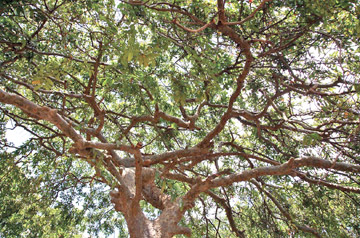
A beautiful view of Kumbuk tree. |
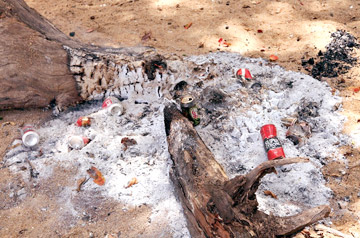
Beer cans and other disposals have been burnt using huge logs
causing damage to the environment. |
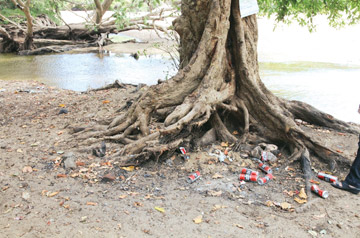
Beer cans disposed under a Kumbuk tree |
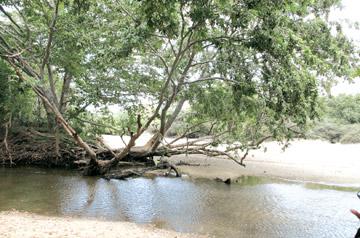
A beautiful Kumbuk tree on the Malwathu Oya |
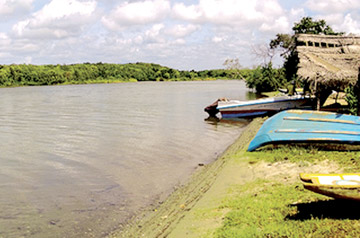 |
| A view of
mangrove forest in the lagoon. |
Gange Wadiya is situated in the Puttalam district along the Mannar
road close to Eluwankulama in the Wilpattu National park border. This is
an attractive location to promote tourism. The Fisheries industry is the
main livelihood of the people who live here. A large number of Muslim
families live in Gange Wadiya.
This village was under LTTE attack at one time. Some villagers said
after attacking Anuradhapura, terrorists escaped to the Wilpattu forest
through Gange Wadiya. Now the Navy has set up a camp in Gange Wadiya. It
comes within the administrative boundary of Wanathawilluwa Divisional
Secretariat Division. Public Transport is not available to this village.
Three-wheelers, motor cycles and bicycles are used by the people for
transportation.
Eventhough this area is not familiar to foreigners, local tourists
visit in large numbers. Because Gange Wadiya is located close to the
Kala Oya invaluable Kumbuk trees are found all around the area. Those
who visit this area cause severe damage to the environment by throwing
polythene bags, food waste, beer cans and bottles.
Garbage which is collected from the area is burnt under the roots of
the Kumbuk trees which are hollow. Due to such activities, a large
number of Kumbuk trees unique to the area are destroyed. Many trees have
already died.
The Fisher community lives in the village and undergo immense
hardship in getting drinking water. They go to the Malwathu Oya to take
water for drinking. Drinking water is given to families in this village
but it is not sufficient. People can be seen going in canoes with
vessels to take water along the Malwathu Oya. Although it is a beautiful
sight it causes immense hardship to the villagers.
Women in the region go fishing in canoes with their husbands. If
pollution by visitors continues, Gange Wadiya will definitely lose its
natural beauty. Environment activists should come forward to protect its
biodiversity while providing facilities to local tourists.
Ancient Kumbuk trees are found in the banks of the Kala Oya and other
places in Gange Wadiya, damage caused to the environment must be
stemmed.
Investment Promotion Minister Lakshman Yapa Abeywardena plans to
promote tourism in the Gange Wadiya area.
Youth who visit the Wilpattu National park hunt animals for food. Due
to this rare animals such as rabbits, deer, jungle fowl and other
animals are gradually diminishing.
Wild elephants can be seen roaming in the night on the way to Gange
Wadiya.
Entrance is free. If a nominal amount charged from visitors, the area
will turn into a popular tourist area.
A program has been initiated to keep the Gange Wadiya area clean .
The BOI has started a program to distribute dustbins in the Gange Wadiya.
"We have instructed the Wanathawilluwa Pradeshiya Sabha to keep dustbins
in suitable places where people gather in large numbers".
The Wanathawilluwa Pradeshiya Sabha has been requested by the BOI to
deploy an officer to monitor the activities in the Gange Wadiya area.
W. Emmanuel a resident of Gange Wadiya said that it is clear that
there are intentions to turn the area into a tourist resort and it would
bring a better livelihood to people while providing a large number of
direct and indirect jobs. "We are not poachers, we are fishermen and
regard this place as our home, despite the fact that even basic
facilities are not available. Even drinking water is brought using
canoes from sources 5 km distant.
"In 1996 the LTTE raided this place and killed 16 innocent people in
the village. There were women and children among the victims. "At that
time no one was willing to come to these areas, but today with the dawn
of peace, Gange Wadiya is gradually turning into a tourist destination"
Emmanuel said.
|
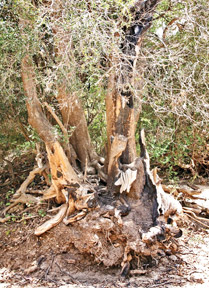
A Kumbuk tree set on fire |
With the re-opening of the Wilpattu National Park the number of
tourists travelling to the area has increased. Although there are no
tourist hotels in the vicinity, around 300 tourists from the Kalpitiya
area visit the estuary by boats.
This was a dilapidated house and a disused well surrounded by
elephant dung. We later found out that it was a forest department
bungalow and was abandoned due to LTTE threats in the Wilpattu jungle.
To our amazement, there was a green hammock tied between two trees
and we immediately jumped onto it. It was like floating on a pool and
felt heavenly.
The Navy who spent days and nights to protect the people from LTTE
attack, now provide training to navy officers to protect the people from
natural calamities.
After the elimination of terrorism Navy officers in Gange Wadiya camp
are involved in social service. A lifeguard and diving team operate in
the camp. When sudden disaster situations arise they transport medicine
and essential food items to victims. Boat facilities have also been
given to these officers for rescue work.
Moves are underway to promote environment-friendly tourism in this
area where the Kala Oya merges with the lagoon. It is also intended to
popularise aquatic games and provide training to divers. There are 200
people working in the camp including officers, Commander Kosala
Wijesooriya is in charge of the camp. |

